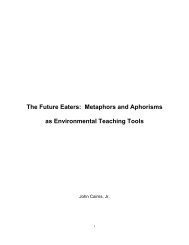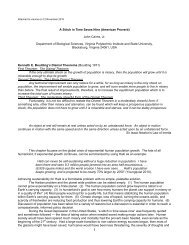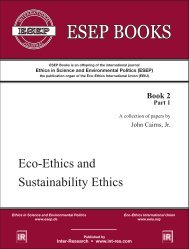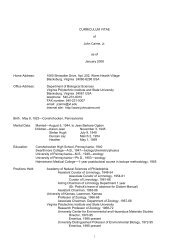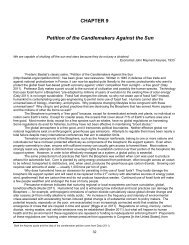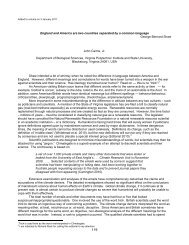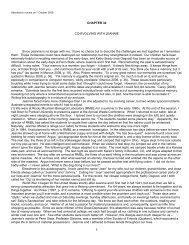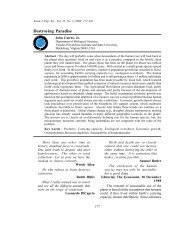252Cairns: Eco-Ethics and Sustainability Ethicsmutualistic relationship between two complex, dynamic, multidimensional systems — human societyand natural systems of which Homo sapiens is a part. Since human society depends upon itseducational system to produce citizens capable of a synthesis that will make sustainability possible,society must transform its structure (based on disciplines) so that reductionist science doesnot threaten or impede development of integrative science. This change must be accomplishedrapidly since a resource crisis is likely in the first half of the twenty-first century, even if some remedialmeasures are taken (e.g. reduction of greenhouse gases), because recovery of natural systemstakes time, often decades or longer.Necessity usually results in new behavior patterns for individuals, new perspectives in government,and changed practices in those industries and corporations anxious to have a long-termmarket. Globalization creates problems but also opportunities for solutions. The global Internetprovides both information and communication opportunities unprecedented in human history. Sustainableuse of the planet will, if successful, represent a superb opportunity for humankind to castoff counter-productive unsustainable practices. This historic endeavor provides a wonderfulopportunity to have a beneficial effect upon the future, which should produce great satisfactioneven though the participants will not live to see it. I believe Ethics in Science and EnvironmentalPolitics has an opportunity to make a major contribution to this paradigm shift, which will representa defining moment in human history. Due to globalization, survival, which has required a holisticperspective for most of human history, is more important now than ever.ACKNOWLEDGEMENTSK Cairns transferred the handwritten draft to the word processor. D Donald provided editorial assistance.LITERATURE CITEDAllen J (2003) Ethnospherics. ESEP 2003:7–24Almeida SP, Case SK, Fournier JM, Fugii H, Cairns J Jr, Dickson KL, Pryfogle P (1978) Analysis of algae samplesusing coherent optical processing. In: Proceedings of the International Commission for Optics, ICO-11, Madrid, Spain, pp 351–354Anderson RC (1998) Mid-course correction: toward a sustainable enterprise: the interface model. ChelseaGreen Publishing Co, White River Junction, VTBoulding KE (1956) The image. University of Michigan Press, Ann Arbor, MICairns J Jr (1996) Determining the balance between technological and ecosystem services. In: Schulze PC(ed) Engineering within ecological constraints. National Academy Press, Washington, DC, pp 13–30Cairns J Jr, Dickson KL, Slocomb JP, Almeida SP, Eu KHT (1976) Automated pollution monitoring with microcosms.Int J Environ Stud 10:43–49Dubos R (1970) Reason awake. Columbia University Press, New YorkEhrlich PR (2000) Human natures. Island Press, Washington, DCEldredge N (1999) The pattern of evolution. WH Freeman and Company, New YorkHeerwagen JH, Orians GH (1993) Humans, habitats and aesthetics. In: Kellert SR, Wilson EO (eds) The biophiliahypothesis. Island Press, Washington, DC, p 138–172Lovelock J (2000) Preface. In: The ages of Gaia: a biography of our living Earth. Oxford University Press,Oxford, UKNatrass B, Altomare M (1999) The natural step for business. New Society Publishers, Gabriola Island, BritishColumbiaNorton BG (2003) Searching for sustainability. Cambridge University Press, Cambridge, UKSzent-Gyorgi A (1962) The persistence of the caveman. Sat Rev 7July:11Wilson EO (1998) Consilience: the unity of knowledge. Random House, New York
253Article 29Reproduced from Ethics in Science and Environmental Politics (ESEP) with permission of Inter-ResearchESEP 2004:39–43www.esep.deSustainability Ethics: Tales of Two CulturesJohn Cairns, Jr.Department of Biology, Virginia Polytechnic Institute and State University, Blacksburg, Virginia 24061, USA.E-mail: jcairns@vt.eduABSTRACT: Two small, isolated Pacific islands colonized by Polynesians experienced quite differentfates — Easter Island suffered a major ecological collapse, while Tikopia appears to haveattained sustainability. Both events occurred before European contact and provide valuable evidencein the discussion of sustainability ethics.KEY WORDS: Sustainability · Sustainable development · Carrying capacity · Human conscience ·Sustainability ethics · Cultural norms · IndividualismWe appear to be a species out of control, setting in motion processes that we do not understand withconsequences we cannot foresee.Lester R. BrownTo couple the concept of freedom to breed with the belief that everyone born has an equal right to thecommons is to lock the world into a tragic course of action.Garrett HardinCARRYING CAPACITYElevators, bridges, automobiles, ships, airplanes, lifeboats, and Earth have a finite carryingcapacity for humans. Carrying capacity refers to the maximum, equilibrium number of organisms ofa particular species that can be supported indefinitely in a given environment. A good illustration ofexperiencing carrying capacity can be related in the tale of two small, remote islands in the PacificOcean on which the human population encountered carrying capacity limits and responded inquite different ways. Much can be learned from their two case histories. The time period is after colonizationby Polynesians and before European contact (Kirch 2000). Both islands had no landmassnearby that might furnish resources, nor could the people depend on outside help. The size of theislands allowed a physically fit person to view personally the terrestrial resources available as wellas the nearby ocean.Globalization has made humankind aware of how interconnected and interdependent society hasbecome. Astronomy and space travel have shown that Earth is a small blue dot in a galaxy thatappears lifeless, although life may exist elsewhere in the universe. Even if other parts of the universe



